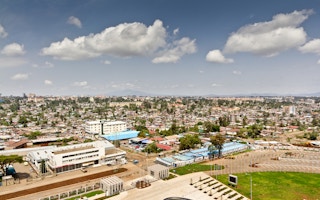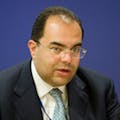When the Millennium Development Goals (MDGs) expire at the end of this year, the world will have made significant progress on poverty reduction, the provision of safe drinking water and sanitation, and other important objectives. In order to ensure that the next development agenda, underpinned by the Sustainable Development Goals (SDGs), produces even greater progress, world leaders must refine and optimize the MDG framework – particularly when it comes to financing.
To continue reading, subscribe to Eco‑Business.
There's something for everyone. We offer a range of subscription plans.
- Access our stories and receive our Insights Weekly newsletter with the free EB Member plan.
- Unlock unlimited access to our content and archive with EB Circle.
- Publish your content with EB Premium.
The MDGs brought together governments, multilateral organizations, and NGOs to support the implementation of key programs and policies, with global partnerships advocating for resources. In order to maximize efficiency, the MDGs were pursued and funded individually, rather than as a unit, with new initiatives being implemented when targets were not being met. But this approach created some imbalances, with global health and education initiatives attracting far more financing than other efforts.
This sectoral model must be reevaluated ahead of the next development agenda’s launch to ensure that such imbalances do not persist. Doing so is particularly important, given that the proposed SDGs attempt to incorporate the social, economic, and environmental dimensions of sustainable development, making them more comprehensive and interdependent than the MDGs.
World leaders will have three critical opportunities to develop an integrated approach. In July, the United Nations will hold a conference on financing for development in Addis Ababa, Ethiopia. In September, the UN General Assembly will convene to launch the SDGs. And in December, world leaders will attend the 21st Conference of the Parties (COP21) of the UN Framework Convention on Climate Change, where they are expected to adopt a binding global agreement on the long-term reduction of greenhouse-gas emissions.
Given the vital importance of finance in supporting development initiatives, it should be among the first issues to be addressed. World leaders must avoid making the same mistake they made with the MDGs – the implementation of which was delayed for two years, until financing was agreed at the 2002 Monterrey Consensus – by developing an effective and traceable financing program at their earliest opportunity: the conference in Addis Ababa.
The urgency consists partly in the scope of financing that the SDGs will require – an amount that will far exceed the resources needed to implement the MDGs. Beyond funding for initiatives aimed at eradicating poverty and hunger, improving health and education, strengthening governance, and promoting gender equality, investments must be made in infrastructure, energy, and agriculture. The SDGs will also call for financing global public goods, including environmental protection and efforts to combat climate change and mitigate its impact.
“
The urgency consists partly in the scope of financing that the SDGs will require – an amount that will far exceed the resources needed to implement the MDGs. Beyond funding for initiatives aimed at eradicating poverty and hunger, improving health and education, strengthening governance, and promoting gender equality, investments must be made in infrastructure, energy, and agriculture.
With governments and international donors unable to foot the bill alone, they must develop programs and policies that can channel a larger share of global savings, which now amount to roughly $22 trillion annually, toward the SDGs. Specifically, national and local governments and international financial institutions should leverage their resources by deploying tailored financing measures, including public-private partnerships, performance-based instruments, and a variety of credit and political risk guarantees. This range of financing measures, adjusted to each country’s needs and strengths, can help mitigate risks and improve collaboration.
This will be especially pertinent for emerging middle-income economies. As these countries strengthen their creditworthiness and improve their capacity to manage debt and equity instruments, they will have at their disposal a larger toolkit of financing instruments with which to attract private-sector resources.
By tapping private resources, emerging economies can free up much-needed official development assistance (ODA), which can then be channeled toward poverty-reduction efforts and to countries that international private financial flows largely bypass (and that thus have a lower capacity to raise resources domestically). Viable financing solutions should be considered on a case-by-case basis across countries and sectors.
To ensure that the Addis Ababa conference produces the needed action, the World Bank, the International Monetary Fund, and several regional multilateral development banks (MDBs) are working on a joint approach that will leverage billions of dollars in grant and ODA funds into the trillions needed to finance the post-2015 agenda.
MDBs already help, individually and collectively, to leverage scarce official assistance to attract enough capital to finance development projects. In fact, their financial leverage is built into their structure: they are fundamentally financial institutions, funded efficiently by small amounts of paid-in capital, which is backed by callable capital from shareholders.
The MDBs also have significant operational leverage, stemming from their capacity to establish – through innovation, intermediation, and market creation – conditions that are attractive to the private sector, thereby producing sustainable solutions and investment opportunities. And they provide integrated, cross-sectoral inputs, by investing in the systems, institutions, and capacities that are needed to achieve development goals.
To support this joint approach, the World Bank is providing an analysis, based on 11 case studies, of how countries in diverse circumstances can use a combination of public, private, domestic, and international sources of financing most effectively to fund the implementation of the SDGs. The analysis will also recommend a pragmatic approach to assessing the SDGs’ financing needs at the country level.
The MDBs will discuss their common approach at April’s IMF-World Bank Group Spring Meetings. Their ability to identify tangible financing solutions will be crucial to set the stage for the Addis Ababa conference in July – and, indeed, for the successful implementation of the SDGs and the post-2015 development agenda.
Mahmoud Mohieldin is Corporate Secretary and the President’s Special Envoy at the World Bank Group. Marco Scuriatti is Special Assistant at the Office of the President’s Envoy on the Post-2015 Agenda at the World Bank Group.
Copyright: Project Syndicate, 2015.
www.project-syndicate.org











